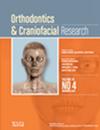Effects of Attachment Orientation and Designed Vertical Movement on Molar Distalisation With Clear Aligners: A Biomechanical Finite Element Study
Abstract
Objective
This study aimed to evaluate the effects of molar attachment orientation and designed molar vertical movement on molar distalisation using clear aligners. Specifically, the study focused on the impact of vertical forces during upper second molar distalisation.
Materials and Methods
A three-dimensional finite element analysis was conducted to simulate upper molar distalisation using clear aligners. Four attachment orientations (0°, 45°, 90° and 135°) were designed. The study included three scenarios: distalisation alone; distalisation combined with intrusion; and distalisation combined with extrusion. The displacement tendencies and stress distribution on the second molar under various attachment orientations and vertical movements were analysed.
Results
Molar distalisation resulted in buccal tipping, distal tipping and intrusion tendency in all models. The molar with 135° attachment orientation exhibited the most significant distal movement under intrusive force, while the one with 45° attachment showed the greatest distal movement under extrusive force. Additionally, greater distal movement was achieved with intrusive force compared to extrusive force, likely due to improved aligner grip on the attachments and teeth during intrusion.
Conclusion
Attachment orientation significantly affects the effectiveness of molar distalisation and vertical movement with clear aligners. The 90° attachment group achieved the most effective molar distalisation. The 135° attachment is more effective under intrusive force, while the 45° attachment is preferable under extrusive force.

 求助内容:
求助内容: 应助结果提醒方式:
应助结果提醒方式:


